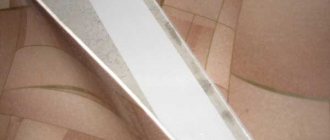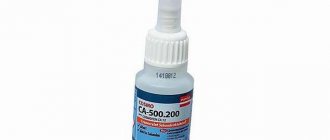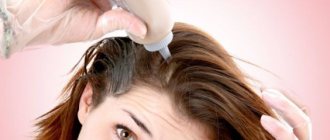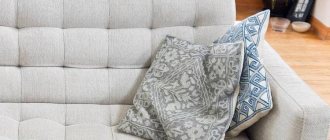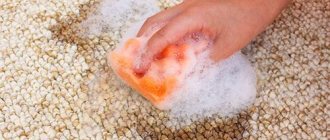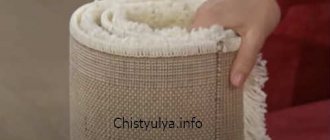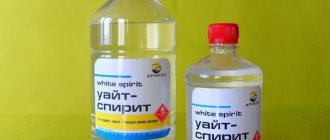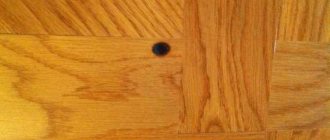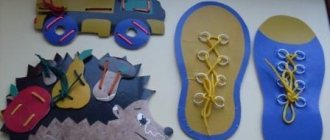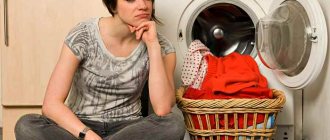Have you dropped iodine onto a light-colored floor and don’t know how to remove iodine from linoleum? Don't worry, it can be fixed! There are many simple ways to remove brown iodine stain. One of the methods will definitely help you.
Let's start with the fact that iodine is a volatile substance and will disappear over time. But it will take a week, no less. If you need to remove the stain urgently, use one of the methods listed below. What will help us in the fight against iodine stains?
Starch
The most economical way would be to use potatoes to remove iodine from linoleum. You need to cut the potato in half and rub it on the stain. If you have potato starch lying around on your shelf, you can use it instead of potatoes. You need to pour 1-2 tablespoons of starch onto the stain and pour water over it to get a mixture similar to thick sour cream. Then cover with a cloth and leave for 9-10 hours. After 10 hours, remove the slurry and wash the area with a sponge and soapy water.
How to remove iodine stains using traditional methods
If there is dirt on the linoleum, it is recommended to wipe it off with a damp, clean cloth or napkin. This option is suitable in cases where the antiseptic has not been absorbed into the coating. You can also use folk remedies:
We recommend reading: How to remove brilliant green from linoleum
- a mixture of table salt and soda. In this case, you will need to wipe the area with a cloth moistened with warm water, and then apply a paste made of salt and baking soda to the stain. After this, cover with a small piece of cloth. After 11 hours, the pulp is removed and the linoleum is thoroughly washed;
- lemon – this option is great for fresh stains. Lemon juice is applied to a cotton swab and scrubbed thoroughly.
We recommend reading: Baking soda: beneficial properties, uses, how to take
If there is a need to remove iodine from the sofa, you can use the following methods:
- milk is used when iodine has not had time to be absorbed into the upholstery of the sofa. Milk is applied to problem areas and left for literally 25 minutes. If after such manipulation the mark cannot be wiped off, then it is recommended to use special means;
- acetone is the most effective remedy, but it is important to consider that, having a high level of aggressiveness, the product can harm upholstered furniture. Initially, it is recommended to check the reaction of the upholstery to acetone in an inconspicuous area.
When iodine gets on a wooden table, an excellent solution would be to use the following methods:
- hairspray - you need to spray a small amount of hairspray, then carefully scrub the area of contamination with a toothbrush and leave for 1.5 hours. If the mark has faded, but it was not possible to wipe it off completely, then repeat the procedure;
- vinegar. In this case, take 9% vinegar. Moisten a cotton pad with it and wipe the problem area on the table. The secret is that iodine enters into a chemical reaction, after which crystallization begins and it is quite easy to wipe off the existing trace.
As practice shows, fresh stains are much more effective at removing.
Attention! It is recommended to follow safety precautions when working with acetone.
Comet type powder
Everyone, no doubt, has cleaning powder for stoves and plumbing fixtures in their kitchen. Cleaning powder can be different: “Komet”, “Pemolux”, “Velvet”, and so on. These powders contain soda, abrasive, and alkali. Wet the problem area, sprinkle cleaning powder on it, and leave for 5 minutes. Then rub the area with a damp sponge. Your spot will disappear or become much paler.
Removing pollution using traditional methods
If you wipe off the spilled iodine immediately, this will most likely resolve the situation. You will need a clean rag and a couple of minutes of time. To enhance the effect, you need to moisten it with water and rub the stain with little effort.
If time is lost and the contamination cannot be removed with water and a rag, then use the following substances:
- alcohol or any solutions based on it that do not contain dyes;
- baking soda;
- starch;
- citric acid or fresh lemon.
Citric acid can be successfully replaced with regular ascorbic acid or aspirin tablets. They contain it in large quantities and are quite capable of coping with the task.
Using an alcohol solution
Pure alcohol or liquids that contain it are perfect for these purposes. The main thing is not to use those that can aggravate the situation and color the stain in new colors or make the stain greasy.
The process of cleaning the surface consists of rubbing the stained laminate or linoleum with a rag soaked in an alcohol-containing liquid. If the stain is old and difficult to clean, you need to pour a little alcohol directly on it and wait a while. Then repeat the procedure.
After successfully removing iodine from linoleum, rinse it well with plain water and wipe dry with a cloth. It will also be useful to ventilate the room. Ethanol has a persistent unpleasant odor and can cause discomfort in people who are especially sensitive to it.
Using Baking Soda
This product is very widely used in everyday life. Washing dishes, cleaning tiles, bathtubs or other plumbing fixtures is rarely complete without baking soda. It will also help remove iodine stains from linoleum without any difficulties. But you will have to follow some technology so as not to damage the new floor surface.
Place a couple of teaspoons of baking soda on the stained area and moisten it with water. A paste should form, which will need to be rubbed into the stain with a clean, damp cloth with little force.
After a few minutes, when the solution begins to corrode the dirt, it needs to be rinsed with water. Despite the seeming harmlessness of baking soda, all required precautions must be taken. If used incorrectly, there is a risk of getting a mild chemical burn.
In particularly difficult cases, if the stain is not removed after the procedures, you should proceed as follows:
- rinse the surface and sprinkle it with several tablespoons of baking soda;
- moisten it, bringing it to a paste consistency;
- cover with a damp cloth and leave for several hours.
During this time, the soda will completely dissolve the stain and all that remains is to wash the floors. The surface will be clean and traces of iodine will disappear.
Cleaning linoleum with starch
If you don’t have soda on hand or other handy household products to clean the floor covering from dirt, then you can use ordinary potatoes, which, as a rule, are always available in any home. In this case, the ideal solution would be to use pure starch, but if it is not available, then the vegetable itself in its original form will do.
Cleaning with starch powder is similar to baking soda, but with the tuber you will have to tinker a little. For these purposes, it is advisable to use not the largest one available, but not the smallest one either. It must be cut into two parts exactly in the middle and, holding one half in your hand, rub the stain.
After some time, cutting off a small layer from half of the used part of the tuber, repeat the procedure. You need to do the same with the second half of the potato. Upon completion of the entire procedure, the floors must be washed and dried.
Cleaning the surface with lemon
Citric acid has good cleaning properties. Its use in everyday life is not limited solely to cooking. It will successfully help deal with many stains, including iodine on the floor.
The process consists of rubbing the stained area with a damp rag, to which a paste of citric acid moistened with water was previously applied. The procedure is repeated until iodine completely disappears from the linoleum or laminate. It is not recommended to remove dirt with a powder that is poorly saturated with moisture. This may result in subtle scratches on the floor covering.
If you don’t have concentrated powder at home, fresh fruit will do. After cutting it into two parts, you need to rub the stain with them until it comes off.
Adviсe
Do not forget that each type of linoleum is good in its own way, and not every type will withstand the “test” by all means, and therefore if, when using one product, linoleum begins to lose color, cleansing with this substance should be stopped and another method, less chemical, should be tried.
If the stain is minor and does not change the appearance of the room, or there is no money, time or effort to remove the stain, then you should not panic. You can just wait a few weeks without paying attention to it. You yourself will notice that the stain has disappeared and evaporated. And this is not fiction. Iodine is a volatile substance and when exposed to sunlight, it disappears. Therefore, you should create conditions for more light to hit the spot, and it will evaporate.
How to remove iodine from linoleum (recommendations)
Undoubtedly, there are surfaces (tiles) from which it is easy to remove traces of iodine. To do this, you need to moisten a cloth and rub. We try a similar method on another surface: we wipe off the iodine from the linoleum - but to no avail. What is the reason? It's all about the structure of the polymers that make up linoleum. The antiseptic is built into this floor covering, and quickly washing off iodine from linoleum turns out to be very problematic. There are quite a lot of different tips on how to wash off iodine from linoleum.
Recommendations for neutralizing iodine from linoleum:
- Don't try every detergent you can find. Such “amateur activity” can lead to damage to the floor covering. Analyze the various sources well (especially those with an emphasis on chemistry, since iodine is a substance that dissolves in liquids). Thus, we wipe off the iodine from the linoleum once - so that the spirit is not there!
- Iodine, according to its chemical properties, disproportions (dissolves) in aqueous (when heated) and alkaline media. Therefore, you can change the pH of the solution and make it alkaline (by adding soda) and, after slightly heating, apply it to the area of linoleum with an iodine stain.
- To quickly wash off iodine from linoleum, you can use chlorine-containing detergents. But the important point here is the possibility of allergies in you and your family members! The fact is that polymeric organic compounds (kitchen products) with chlorine act as strong allergens and are undesirable for contact, especially for people with a predisposition to allergies. Therefore, it is better not to use this method if there are children in the apartment, especially small ones.
How to wash iodine
Careless use of brilliant green causes stains to appear on the floor surface. To remove them you can use:
- nail polish remover;
- plain acetone;
- hydrogen peroxide.
Any of the selected products is applied to a prepared cotton swab, which is used to intensively scrub the stain. Rub until the green color disappears completely. After completing the procedure, the treated area is washed with a warm solution of soap and water.
Iodine and brilliant green are a problem, you need to act as quickly as possible before it is absorbed! If light linoleum. try to wash with a 3-5% solution of hydrochloric acid, alcohol or acetone will do. If the iodine has already set in, soak the stain in a bleach solution and let it sit for a while. Alternatively, you can use Vanish, Mister Proper or other cleaning products.
...what would be linoleum. You can fill the stain with an aqueous solution... after...
...stains from linoleum depend on what caused the stain......
Insulation of walls of a residential building made of sand block 40*20*20
Good day, please advise how to solve my problem. The fact is that the roof of a private house in the village recently began to leak. It's done.
Solid fuel water boiler?
Hello, dear readers, please tell me where I can buy various consumables and other household goods for a private home, I really need to buy a boiler.
Buy sliding doors for built-in wardrobes?
First of all, I appeal to builders and experts in repairs, as well as those who supply materials and equipment for construction, please tell me.
Turnkey houses
help me choose a company to order the construction of a house.
Where to buy buffer tanks in St. Petersburg?
Hello! We recently completed the construction of a country house in the Leningrad region. I plan to use buffer tanks for heating. Please tell me.
Outdoor fireplaces photo
Outdoor fireplaces (like this one of an unusual shape in the photo) can be located either in already built gazebos or designed together with them. Climatic features.
In general, you can do nothing. Human skin renews itself regularly, so the spots will fade over time. If you can't wait, use:
- Alcohol or any strong alcohol. Dampen a cotton swab or rag and rub the stain firmly. This method is the simplest and most universal, but, alas, is not suitable for those with dry or sensitive skin.
- Hydrogen peroxide or chlorhexidine digluconate. These liquids are sold at any pharmacy at affordable prices and are milder than alcohol.
- Makeup remover. Especially if the green paint gets on the thin skin of the eyelids or lips. The stain will not disappear the first time, but if you wipe the stain 4-5 times a day, it will come off faster.
It is much more difficult to remove green stains from things than from skin. Firstly, not all fabrics can be washed with aggressive detergents. Secondly, you need to act as quickly as possible: the older the stain, the more difficult it is to remove.
If an expensive item is dirty, the best solution is to go to the dry cleaner. For those who are ready to try to wash off the brilliant green on their own, we advise you to arm yourself with:
- Fat cream. The most gentle method for the most delicate items. Apply a thick layer of cream onto the stain, leave for 2-4 hours, and then wash the item with powder.
- Soapy solution. Works great on woolen items. Mix 3-5 tablespoons of liquid or grated bar soap in ½ liter of water. Treat the stain with this solution or soak the entire garment. Leave the green stuff to soak for 10–30 minutes and rinse the items with clean water.
- "Whiteness." Stains on light-colored clothing can be treated with this cheap bleach. Afterwards, the item will need to be washed in a washing machine with your usual detergents.
- Stain remover. The household chemicals market regularly pleases us with new inventions. Use your favorite bleach or stain remover, following the manufacturer's instructions. Most often, it is enough to apply the product to the dirt and then add it to the washing machine.
If furniture made of plastic, glass, varnished wood, chipboard, MDF, leather or leatherette is stained with green paint, wipe the surface with a damp cloth and carefully work on the stain with an eraser. If the eraser doesn't help, try removing the green paint with alcohol. If the furniture is made of untreated wood, unfortunately, you will have to use sandpaper.
If green paint gets on the fabric, follow the recommendations for removing stains from clothing. Just in case, we advise you to first check the reaction of the material to the cleaning agent. And if the furniture is especially valuable to you, contact a dry cleaner.
At home, it is safest to use a special stain remover. Apply the detergent concentrate or solution (according to the instructions) on the stain for several hours, and then wipe off the residue with a damp cloth.
Iodine disappears from the skin even faster than brilliant green. The following will help speed up the process:
- Soap. Wash your skin thoroughly with soap. Household stuff, although it doesn’t smell very nice, will be the most effective. Especially if you add a good stiff brush to it.
- Baking soda. Wet the skin with water and rub with baking soda. Do this over a sink or basin: the powder will fall off during the process. Leave the baking soda on the stain for 10-15 minutes, and then wash off the residue. After this procedure, it is advisable to apply a moisturizer: baking soda dries the skin.
- Alcohol. Wipe the stain with a cotton swab dipped in alcohol or strong alcohol - the stain will become noticeably lighter.
- Hydrogen peroxide. Wipe the skin with a cotton swab soaked in this antiseptic. Peroxide penetrates deeply into the pores and is safe for the epithelium. It is great if you need to wash off iodine from your face.
- Lemon. Squeeze some juice onto a cloth and rub the stain vigorously. Be careful with mucous membranes: if you clean the area around the eyes, mouth or nose with lemon, you can get burned.
Iodine is difficult to remove from fabric, but the sooner you begin to eliminate the stain, the greater the chance of restoring cleanliness to your clothes. You can remove dirt:
- Potato starch. Soak the items in warm water for 10–20 minutes and then wring them out. Sprinkle starch generously onto the stain, rub into the fibers with your hands and leave for 15 minutes. Rinse off the starch with clean water. If the stain turns out to be particularly stubborn, repeat the procedure several times. Then wash the clothes in the washing machine as usual.
- Ammonia. Add 10–15 drops of ammonia to a glass of water, pour it into a basin with clothes and add a liter of warm water. Leave the items to soak for 15–20 minutes, then rinse them and wash as usual.
- Acetone. If something is dirty that you don’t want to wash, wipe it with a cotton swab soaked in acetone. Nail polish remover will also work.
We suggest you familiarize yourself with How to dye jeans without paint
If the furniture is upholstered with fabric, use methods for cleaning clothes. Don’t worry about wooden decorative elements: the iodine will evaporate from their surface on its own. Furniture made of plastic, glass, lacquered wood, chipboard, MDF, leather or leatherette can be washed:
- Potatoes. Cut the tuber in half and thoroughly wipe away any dirt. If necessary, the potatoes can be left on the stain for several hours: they will absorb the remaining iodine.
- Fixer for photographs. If you are an amateur photographer, there will be no problems with iodine removal. Take sodium thiosulfate and treat the stain with it. Then wipe the surface of the furniture with a damp cloth.
- Ascorbic acid. Dissolve 1-2 tablets in 100 ml of water. Soak a cotton swab in the liquid and wipe the stain until it disappears.
How to wash off iodine from linoleum (instructions)
Now we wipe off the iodine from the linoleum in a way that is safe for others. Which of the proposed methods is the safest? Iodine is dissolved in soda without the release of harmful side gases. But there is another interpretation of this method (as opposed to the one proposed above): you first need to moisten the stain with hot water. Afterwards, dilute the soda solution (in a 1:1 ratio with water), dip a cloth in it and place it on the iodine-contaminated area of linoleum (10-12 hours). If this method does not work (and this may happen if the iodine stain is not fresh, but already weathered or located in cracks in the floor covering), dilute two tablets of ascorbic acid (similar to the soda method) and apply to the area with the stain. This is the most effective way to neutralize iodine.
Indeed, according to physicochemical characteristics, iodine is a volatile substance. If you don’t need to get rid of the stain every minute, you can wait: the antiseptic smeared onto (undamaged) linoleum will disappear on its own within a month. To speed up the spontaneous course of the reaction, you can pass direct sunlight to the stain - then the weathering period can be reduced several times.
How to clean linoleum from iodine stains (video)
Remember that any stain can be removed with the right approach.
How to care for linoleum
It is easier to prevent any problem than to solve it. It is important to handle pharmaceutical drugs carefully and keep them away from children. The described floor covering is afraid of hot water. When heated, the protective polymer layer of the material softens. This allows dirt to penetrate deep into the linoleum structure. It is much more difficult to wash such contaminants. Therefore, it is important to carefully study the proposed material and choose the right means to combat typical contaminants.
Knowing how to remove iodine from plastic, linoleum, and the surface of wooden furniture, you can quickly save your favorite things and extend their service life.
If some remedy does not help, do not despair. Perhaps you need to try another method. The main thing is not to combine several options at once, but to carry out cleanings over a long time interval. Then the process of getting rid of stains will be crowned with success.
Source
How to properly remove iodine from linoleum: step-by-step instructions
In order not to ruin everything completely, you should not use any detergents that you have in the house. A mixture of different components and their interaction with iodine can give impetus to the development of uncontrolled chemical reactions. Then the coating will be irretrievably lost and will have to be replaced.
Iodine is a substance that dissolves well in liquids. You need to use this feature and look for products that contain a lot of this substance. Aqueous and alkaline solutions are best suited for these purposes. Chemicals that contain chlorine will help remove old stains. If no one in your family is allergic to this powerful chemical, you can use it without much concern.
The easiest way to remove iodine stains is with baking soda. This option is the safest and most effective, as practice shows. The instructions for using the powder are extremely simple:
- The front surface is moistened with a damp sponge.
- Sprinkle a spoonful of baking soda onto the stain.
- The dirty area is covered with a wet rag and left alone for ten hours.
- At the end of the period, the stain is washed off with a coarse detergent (Chistole, for example).
- If after these manipulations the iodine stain does not disappear, the procedure is repeated.
Instead of soda, you can use potato starch. A mixture is pre-prepared from it and cold water, with a consistency similar to thick sour cream. It is applied to the dirty area and left for ten hours. Afterwards it is removed with a damp cloth. Linoleum is washed with soapy water.
When starch is not available, experts recommend using potatoes cut in half instead. The cut root is applied to the iodine stain. Then the dirty surface is thoroughly wiped with it.
Lemon is another component that can help save the flooring. To do this, you need to cut it in half and squeeze the juice from one half. Dip a cotton swab in it and wipe the iodine stain. Afterwards, the floor surface is wiped with warm water. This method is good if iodine has just gotten onto the linoleum.
It is better to remove old stains with alcohol solutions. Lotion or cologne will do. The main thing is that the liquid is colorless. Soak a cotton swab in it, apply it to the stain and rub as hard as you can until it turns pale. To achieve the desired effect, it is often necessary to repeat several such treatments.
Ascorbic acid will also work. It is sold in tablets at any pharmacy. It is first dissolved in two tablespoons of warm water. A cosmetic disc is dipped in the resulting solution and the dirty surface is wiped with it. This method is used infrequently: not everyone knows how to remove iodine stains on linoleum using ascorbic acid tablets. But this method must definitely be adopted and used in the fight against old stains.
